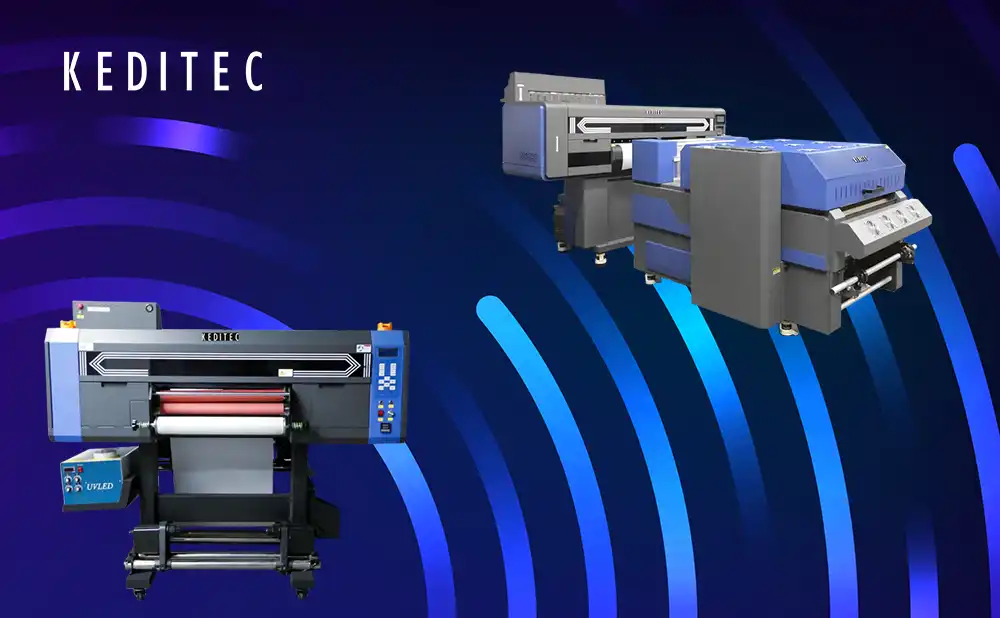In the era of rapid development of digital printing technology, DTF and UV-DTF printers have emerged in different industrial sectors with their unique advantages. They have not only revolutionized traditional printing models but also opened up more possibilities for personalized and customized production. A deep understanding of the differences between these two types of printers is crucial for enterprises to select suitable production equipment and achieve cost reduction and efficiency improvement.
I. Technical Principles: Process Path Determines Application Characteristics
DTF Printers
DTF printers employ the direct-to-film transfer technology. They print patterns on films using water-based inks. Subsequently, a bonding layer is formed by sprinkling hot-melt powder. The inks are then cured through baking at 160 – 180°C, and finally transferred to textiles via heat pressing. Among these steps, white ink underlay ensures coverage on dark fabrics. Powder sprinkling and curing utilize the electrostatic adsorption of hot-melt powder to bond with the inks. Heat pressing penetration enables the adhesive to penetrate into the fabric fibers, enhancing the adhesion of the patterns.
UV-DTF Printers
UV-DTF printers utilize the UV curing transfer technology. They print patterns with UV oil-based inks. During the printing process, LED UV lamps cure the inks instantly. Then, a crystal label is formed through automatic laminating, and finally, it is directly pasted onto hard surfaces. UV curing ensures that the inks crosslink rapidly within 0.5 seconds. The dual-film structure (Film A with adhesive ink-absorbing layer and Film B as transfer protective layer) not only simplifies the operation process but also achieves a three-dimensional embossed effect through white ink stacking, making the labels more visually impactful.
II. Hardware Configuration: Component Differences Affect Printing Efficiency
Print Heads and Drives
DTF printers mostly adopt piezoelectric print heads, such as Epson I3200 or Ricoh G5, paired with stepper motors and timing belts. The printing resolution can reach 1440 dpi, making them suitable for small-batch and high-precision textile printing. UV-DTF printers often use print heads like Ricoh G6 and Seiko 1024GS, in conjunction with servo motors and magnetic levitation guides. The maximum printing resolution can reach 2880 dpi, ensuring high-quality images even during high-speed printing.
Drying and Consumable Handling
DTF printers rely on a hot air circulation oven to dry the inks at 150 – 200°C. They require a powder shaking machine and powder collection device to handle hot-melt powder. UV-DTF printers are equipped with dual-wavelength UV lamps (365nm + 405nm) to achieve in-line curing during printing. They also integrate an automatic laminating machine to simultaneously laminate Films A and B, significantly improving production efficiency.
III. Inks and Consumables: Composition Characteristics Determine Costs and Applications
Ink Characteristics
The water-based inks used in DTF printers are composed of pigments, water-based resins, and deionized water. They feature good breathability and high color saturation, making them suitable for clothing printing. However, they have poor solvent resistance and a storage period of only 6 months. The UV oil-based inks used in UV-DTF printers are made up of oligomers, monomers, and photoinitiators. They have a fast curing speed, strong adhesion, and excellent weather resistance, allowing direct printing on metal surfaces. Nevertheless, they have insufficient flexibility and are prone to cracking at low temperatures.
IV. Application Scenarios: Each Excels in Meeting Diverse Needs
DTF Printers
DTF printers are widely used in the clothing and home furnishing sectors. They are responsible for 80% of T-shirt printing. They can also be used for printing sweatshirts, sportswear, curtains, sofa covers, etc. Additionally, they have certain applications in printing on special materials such as leather and mesh fabrics.
UV-DTF Printers
UV-DTF printers stand out in the advertising signage, packaging industry, and industrial parts sectors. 65% of metal signage is made using this technology. They can also be applied to printing on cosmetic boxes, wine bottle labels, car dashboard films, and electronic device casings.
V. Selection Suggestions: Match Requirements to Maximize Benefits
Scenarios Suitable for DTF Printers
If the daily output of clothing is less than 500 pieces, the budget is limited (equipment + consumables investment is less than 100,000 yuan), and elastic fabrics need to be processed, DTF printers are an ideal choice.
Scenarios Suitable for UV-DTF Printers
For advertising companies and packaging factories with a daily production capacity exceeding 1000 square meters, those seeking high-value-added products, or requiring outdoor weather resistance, UV-DTF printers can better meet the requirements.
DTF and UV-DTF printers each have their own strengths, and there are significant differences in technical principles, hardware configurations, consumable costs, and application scenarios. When making a choice, enterprises should comprehensively consider their business needs, budgets, and development plans to select the most suitable printing equipment, thereby seizing the initiative in the fierce market competition.

